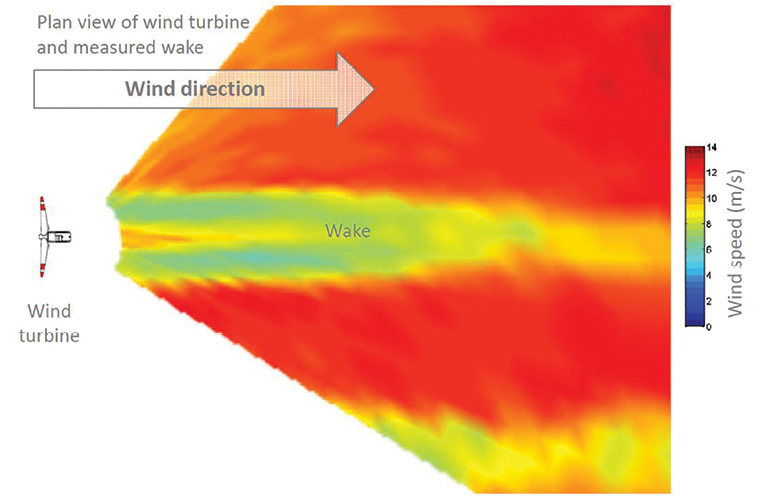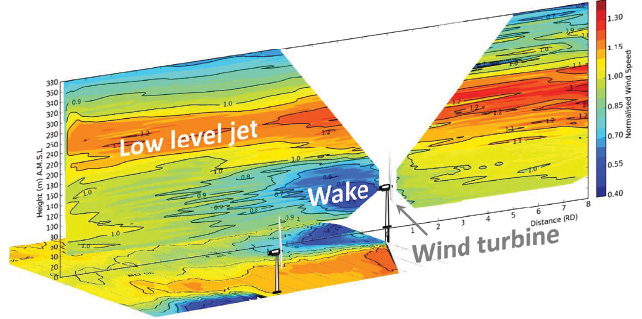IT CAN BE TOUGH for wind farm designers to estimate wakes and how they affect downstream turbines. A variety of conventional wake models have had modest success predicting wake effects. They are now giving way to more accurate methods that make rotor wakes and airflow remarkably visible.
One tool creating a bit of a stir in the assessment community is scanning lidar, a laser-based technology that can measure wind speeds and directions for several kilometers. A scanning lidar is equipped with a system that can sweep a beam horizontally and vertically through space. The device reports on the speeds of wind it finds in the planes that it surveys. A simpler version of the instrument has been used to measure winds at several vertical elevations and can replace met towers.
At the recent AWEA Wind Resource and Project Energy Assessment Seminar, Aaron Culver, Renewable Energy Consultant with SgurrEnergy presented work that discussed an application of the Galion Lidar device. “Lidar has been a valuable tool for validating industry methods,” says Culver.
“The data requirements of established wind energy assessment procedures are based on the limited capabilities of cup anemometry. Now we have methods that offer a much wider range of measurement opportunities and can acquire much richer datasets. We must modify our data requirements to take full advantage of this. These requirements must refer primarily to the desired project outcomes we are trying to achieve rather than limitations which are being overcome,” said Peter Clive, Senior Scientist at SgurrEnergy.
Ground-based devices are easier to deploy and offer the most consistent approach within the current regulatory environment. Equipment is more of a challenge to set up when it is on a nacelle because it must be hoisted up and securely mounted to the nacelle roof, but it provides great images in the same frame of reference as the wakes. The scan angles are generally at hub height, and that makes data processing easier.

Scanning from side to side, the lidar on a nacelle registers wind speeds in a horizontal plane at hub height. The wake is clearly visible and stretches back at least six rotor diameters.
SgurrEnergy deployed the Galion Lidar in 2011 to measure wakes at a U.S. mountain state wind farm that was not meeting preconstruction assessment. When mounted atop a turbine nacelle and aimed downwind, the unit revealed long wake signatures.
“The interesting result is that atmospheric stability has a pronounced effect on the decay lengths of wakes. At night or in a more stable atmosphere, wakes were observed to travel twice as far as they do in the daytime. The bias in the preconstruction assessment arose because there was no assessment for the diurnal variation of atmospheric stability,” says Culver.
In a second campaign in 2012, the University of Stuttgart mounted a Galion Lidar unit on an offshore substation to measure multiple offshore wakes. In another campaign in 2013 in the North Sea, Galion Lidar units were mounted on a turbine to measure single and multiple wakes offshore. “Turbines offshore are huge so there is plenty of room to mount equipment. In this case, one lidar looked forward and one looked aft. The accompanying images show unparalleled spatial resolution and accuracy along with a low level jet just above the rotor tip height.
Under certain atmospheric conditions, offshore wakes can travel far. One offshore wake was observed persisting at least 4km from its creation. These offshore turbines have a 116m rotor diameter making the measured wake at least 34 rotor diameters long.
SgurrEnergy reports that at low wind speeds and up to about six rotor diameters downwind of the turbine, the frequently used Park wake model underestimates the velocity deficits. That is, the velocity loss is much higher than the wake model predicts. “Beyond six rotor diameters, we find the Park model is more conservative and it becomes less pronounced at higher speeds. In fact, at high wind speeds the Park model does remarkably well,” he says.
An investigation of the wind profiles aft of the turbine shows a high-speed region directly behind the nacelle. Winds are less obstructed going around the nacelle as going through the area swept by the blades. “We also see that the vertical profiles do not match our assumptions of a normal wind-shear profile,” he adds.
Another image shows a transfer of energy from aloft to within the array. The transfer is a cumulative effect as well. “As we go further into the array, there is a greater flux of energy. That is probably not surprising since we know that turbine arrays lead to increased turbulence. We know that as turbulence increases there is increased mixing. With increased mixing we expect a greater flux of energy from heights above the turbine tips to those within the array.
“These studies show we can now validate wake behavior for different atmospheric conditions and confirm that the frequently used Park wake model is inappropriate for spacing fewer than four rotor diameters,” says Culver. “We find the model under-predicts the velocity deficit at low-to-moderate wind speeds at distances of up six rotor diameters, although its performance improves at higher wind speed. The best agreement with measured results occurred with wind speeds from 16 to 18 m/s. Lastly, wake models must model the whole array for a more accurate assessment.” 

Although this looks like a simulation, it is real-time measured wind data. SgurrEnergy assessed the scans along a row of several turbines. The top tip height is shown and wind flow is moving towards the positive end of the x axis. It also shows compound wakes and wake interactions.
Filed Under: News, O&M






